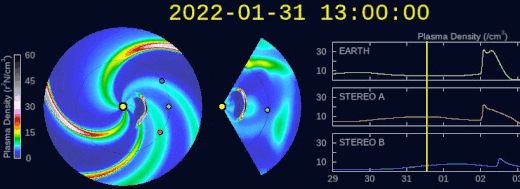Powerful solar flare from recent sun eruption should reach Earth Wednesday
A powerful solar flare has been traveling through space and it will arrive at planet Earth Wednesday (Feb. 2).
In the early hours of Saturday morning (Jan. 30), a coronal mass ejection, a powerful explosion near the sun's surface, erupted into space following an M1-class solar flare. M-class solar flares are medium-sized space weather events that can cause temporary radio blackouts on Earth, according to the European Space Agency.
The burst, which came from a sunspot called AR2936, was especially long-lasting, enduring for more than four hours, astronomer Tony Phillips reported at Spaceweather.com.
Related: The sun's wrath: The worst solar storms in history
This outburst is a type of CME known as a "halo CME," which appears larger than the sun in coronagraph images obtained by sungazing spacecraft as the solar particles approach Earth, appearing like a circular halo.
Solar particles from this halo CME will hit Earth starting Wednesday, as anticipated in a forecast model from the National Oceanic and Atmospheric Administration (NOAA), Spaceweather.com reported.
It is possible that, with the CME's arrival at Earth, we could experience a G2-class geomagnetic storm, according to Spaceweather.com. This is a moderate class, "low hazard" geomagnetic storm, a type of event that could spark hours of auroras from the Arctic Circle into northern United States and as far south as New York. These types of events do not interfere with power grids or satellites.
Breaking space news, the latest updates on rocket launches, skywatching events and more!
This event is seeing the current solar cycle, which astronomers call Solar Cycle 25, stretch past its expected limits. This 11-year solar cycle has seen more sunspots than predicted and is stronger than experts expected, according to Spaceweather.com. While the solar cycle's peak is difficult to predict, experts have said that the cycle could peak around 2025.
Email Chelsea Gohd at cgohd@space.com or follow her on Twitter @chelsea_gohd. Follow us on Twitter @Spacedotcom and on Facebook.

Chelsea “Foxanne” Gohd joined Space.com in 2018 and is now a Senior Writer, writing about everything from climate change to planetary science and human spaceflight in both articles and on-camera in videos. With a degree in Public Health and biological sciences, Chelsea has written and worked for institutions including the American Museum of Natural History, Scientific American, Discover Magazine Blog, Astronomy Magazine and Live Science. When not writing, editing or filming something space-y, Chelsea "Foxanne" Gohd is writing music and performing as Foxanne, even launching a song to space in 2021 with Inspiration4. You can follow her on Twitter @chelsea_gohd and @foxannemusic.


